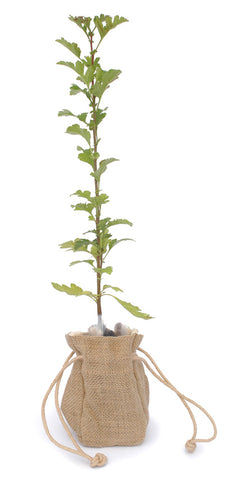Hawthorn Tree Facts and Information
- Latin: Crataegus monogyna
- Native words: Old Irish (droigheann) Scots Gaelic () Old English (hage) Welsh (draenen wen / ysbydadden) eastern Celtic ()
- Ogham sign:
- Height when mature: 10-14m (33-46ft) - standard
- Height after 10 years: 3m (10ft)

Hawthorn botanical description:
The common hawthorn Crataegus monogyna is one of 2 native hawthorns; the other being C. oxycantha. The difference is that monogyna has one seed inside its red fruit, oxycantha two. The Hawthorn tree is not only native to the UK but can also be found across the world in locations such as North America and Asia. The sweet smelling creamy white flowers hawthorns produce (‘May Blossom’) attract the first emerging insects in spring, and cover the branches.
Hawthorn blossom emerges later than Blackthorn, often in late April or May. This time of year gives us a good way to tell hawthorn and blackthorn apart.
The leaves of hawthorn emerge before the flowers, whereas with blackthorn this order is reversed. The leaves are small with 3-6 deep lobes. Short shoots often develop into sharp spines, (shorter than blackthorn) on terminal branches. The fruit or ‘haw’ ripens in October turning a deep crimson. Usually, a few shrivelled haws linger through winter.
The bark on the main trunk is often very shiny in appearance which is a good distinguishing feature. Many hawthorns, especially in upland, have a wind-blasted appearance to the crown, which is swept following the direction of the prevailing wind. As one of our medium sized native trees it can often grow above and beyond 30 feet in height.
Natural History and ancient wisdom:
A pioneer species, hawthorns often form large areas of scrub on neglected land, being followed by British native trees such as ash and oak.
The original hedgerow tree! Hawthorns are intimately associated with boundaries and enclosed spaces. In fact the Anglo Saxon word ‘haga’ means both hedge and hawthorn; clearly, hawthorn was so commonly used in hedges, they were thought of as one and the same. Many hedges were planted by the early English to form deer enclosures; in fact, old thorns growing around high deer shelters in Derbyshire suggest they kept that role.
They are hardy and will grow fast; hence their alternative name “quickthorn”. 200 000 hawthorns were planted between 1750 and 1850 as an enclosure of common land for sheep and cattle grazing expanded. Nevertheless, lone hawthorns can be found, often in upland areas, where sheep have eaten everything else but been deterred by its thorns.
Hawthorns have a long history of appearing in folklore, myth and legend. Its most prominent role was in May Day rituals when its flowers are at their height. Often a single hawthorn remains in a field as a ‘fairy thorn.’
Superstitions also persist about the hawthorn flowers, with some believing it back luck to bring the blossom indoors.
Hawthorn is often ‘laid’, a practice which occurs in winter and requires great skill. It is applied to hedges which have become too ragged and in which the trees have become tall and spindly. Each tree is cut with an axe at an angle diagonally downwards until the trunk is nearly severed from its base; only a sliver connecting the two remains. Then the trunk is lowered gradually down till it lies on the ground following the line of the hedge. Stakes are then driven into the ground to stop the trunks moving and snapping their tenuous link to the roots. In the spring the trunk sends shoots vertically which form a new thick hedge. Hedges must be laid uphill.
Hawthorn has a wide variety of medicinal uses. The leaves, berries, and flowers can all be used in the production of medicine. One of the main uses of Hawthorn is to treat high blood pressure. It was found to widen blood vessels in the body which in turn helps to increase blood flow. Other uses include, treatment of anxiety, stomach cramps and indigestion.

Hawthorn place names in the UK:
- Woodmansterne (Surrey) ‘thorn on the edge of a wood’
- Appleton Thorn (Cheshire)
- Hatherdene (Hampshire) ‘hawthorn valley
- Hathern, (Leicestershire) ‘hawthorn’.
Hawthorn wildlife rating:
A key wildlife tree, providing food for many species, including Duke of Burgundy butterflies, yellow-tail moths, hawthorn shield-bugs as well as being the food plant of the Magpie and Lackey moths.
The larvae of the Small Eggar develop webs in which clumps of caterpillars live on its leaves.
Hawthorn flowers have a sweet smell which is particularly attractive to flies, which can often be seen buzzing around them in spring.
Haws are also important food for wood mice and other small mammals. Many birds especially thrushes eat the fruit in winter, and small birds nest behind its protective thorns.
Hawthorn good points:
- One of the few trees to tolerate exposed positions, hawthorn makes an impenetrable hedge.
- It will grow in most well drained soils and can even be grown in large tubs.
- Though usually seen in a hedge, hawthorn can be grown as a standard tree and clipped to shape.
- Flower buds cover the branches in spring opening into beautiful blossoms.
Hawthorn Tree bad points:
- Sharp spines are to be watched out for and dead twigs retain their thorns when they drop which can puncture tyres.
Buy a Hawthorn Tree
Did you know we can send native tree saplings as a gift to your friends and family? Here at Tree2mydoor, we offer an award winning gift service and can send trees and plants on your behalf to friends and family on special occasions.
Our Hawthorn Tree Gift is popular for weddings as it is a tree of duality and looks perfect in the spring. If our hawthorn gift isn't available at this moment then check out our Rowan Tree Gift instead. It's small and hardy with bright red berries just like the Hawthorn but more garden friendly as it grows without the sharp spines.